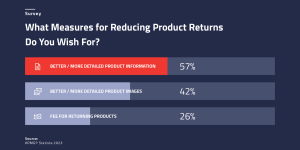Product Communications
5 Steps to Optimizing Your Product Data

Content
Optimizing Product Data and Realizing Business Objectives Even Faster
In our digital day and age, product data and information are of decisive importance for the success of companies. Through the optimization of product data, companies can reach out to their customers in a more efficient manner, boost their online presence, and improve sales. This blog entry goes in-depth on product data – what it is, why it is so important, and how you can optimize it in order to accomplish business goals in a much faster fashion. So, if you want to draw from the full potential of your product data, make sure to keep on reading!
What is Product Data?
Product data is all data and information which describes a product and its properties – it forms the foundation for the presentation of your product. At first glance, this seems to be pretty straight forward, doesn’t it? However, you shouldn’t forget that product data can encompass the full scope of product information: the spectrum ranges from simple data such as names, prices, or colors to complex technical data such as efficiency grades. In short: even a simple product can be described by a large number of product data attributes.
The Importance of Product Data for Your E-Commerce Strategy
Now that we’ve defined what product data is and know just how complex it can be, there still remains the question of how crucial this is to the sales of products. One good answer to this question are the results delivered by an empirical study conducted by KPMG and Statista.
According to this study, 57 percent of the surveyed people wish for detailed product information to avoid personally returning products. 42 percent of the people do also wish for more detailed product images in this context. This means that the majority of people wish for an overall higher quality of product data which can serve as the basis for good purchase decisions without product returns. In short: the quality of data is decisive. This, in turn, is easy to comprehend if you consider the gigantic quantity of products comparable to one another in a vast market such as e-commerce. Customers here have the freedom – or agony – of choice and must, therefore, rely on correct, precise, and elaborate product descriptions and product information. The point being: high-quality data is necessary to stay streets ahead of the competition.
Only this way can you create target-group-oriented product experiences which inspire customers and motivate more purchases. To achieve the desired results, you ought to concentrate on the quality of your data. The following guides you in 5 steps through the best practices for getting the best out of your product data while also optimizing the quality of this data at the same time.
Step 1: Shifting Perspectives – Think Just Like Your Customers Do
The rule of thumb in this context is: customers think in use, not in product properties. So, before your company gets down to business and starts filling product data with life, it’s imperative that you first step into your customers’ shoes and view things from their perspective. Grab pen and paper and write down your answers to the following questions:
- What problems do your product provide solutions for?
- What kind of search terms would you use for googling after these solutions?
- Now, imagine you’ve found just the right product: which attributes and properties are essential to your product?
This step is of utmost importance! After all, this is what constitutes the concentration point where all your target-group-specific information comes together. With it, you create a solid foundation from which all subsequent steps follow, allowing you to realize your objectives in a strategic manner.
Step 2: Unmistakable – Convince with Your Unique Selling Points
After analyzing the needs of your customers, your second step should be to present the unique value your products bring to the table in a clear-cut manner. What makes your products special? How can they make your customers’ lives easier? Even seemingly simple standard attributes such as size, color, weight, or material can already leave a lasting impression.
An example may best illustrate this: you’re selling flowerpots in your online shop. Providing only a simple description or a single image with the headline “Flowerpot” to your customers may, with a very high possibility, be insufficient for motivating purchase decisions. What is unique to your flowerpot? Tell an authentic story which inspires your customers to buy exactly this flowerpot and no other.
There’s one thing in particular that you should keep in mind concerning this step: in the first step, you’ve already determined the concepts and keywords which customers type into search engines to look for products like yours. Make sure to integrate them into your description in meaningful ways. This way, you don’t only provide relevant information to your shop but also make sure that your product or service can be found across different channels.
Step 3: Coherence – Pay Great Attention to Uniform Descriptions
One further golden rule for a successful online shop is the uniformity of your product information. The reason for this is self-evident: providing different currencies, measurement units, or color labels for related products will quickly make your shop appear to be unprofessional and may, consequently, result in consumers opting for the competition instead.
Conduct regular check-ups for validating the uniformity of your product data. For example, have you used the correct currency and the correct measurements in all target channels? Also take the coherence of your product images into account. Make sure that your customers are provided with high-quality images. Such images should clearly display both your product as well as its unique selling points. A uniform presentation of your data is a must-have you should establish across all your online marketplaces.
Step 4: Consistency – Structure Your Product Data
To make it so that customers can find their desired products when browsing you shop, you should sort your product data by specific product groups or categories. Here, too, the same principle applies: look at it through the customers’ eyes. To make this point as explicit as possible, let’s once more refer back to our flowerpot example: judging from your customer’s viewpoint, in which categories would you expect to find what you’re looking for? The answer to this question depends on the scope of your product portfolio. Assuming you’re a specialized flowerpot manufacturer, a categorization by use cases may be adequate. This is an entirely different story, however, if you offer an assortment of diverse products across several domains. In this case, you should neatly organize everything into parent categories and sub-categories to give your shop a simple structure to navigate through. The flowerpot, to stick to the example, would then be available under the category decorations or similar labels.
When it comes to the structuring of your data, here you should keep another rule of thumb in mind: Make things easy for your customer!
After all, if you customers can get straight to their desired article with little to no effort, you simplify the customer journey and make it more experienceable – all the while reducing the bounce rate to the minimum.
Step 5: Single Source of Truth – Manage Your Data Centrally
If you’ve carried out step 1 to 4 consequently to the end, then you’ve already done a lot of things right. The place where you store all this high-quality data and product information, however, is also a decisive success factor for the optimization of your product data. For example, if your product information is spread over various excel lists or multiple digital tools and file systems, you’ll be quick to find out that maintaining your data is a process prone to fatal errors which will not remain unnoticed by your customers.
This does not only cost time but also money. Shop operators who sell a large quantity of products across various online marketplaces should, therefore, invest into a PIM. In a PIM system (Product Information Management), you can structure data in a customized manner for target groups, manage large quantities of data centrally, and automate exports to target channels and all given touchpoints at specified time intervals. At the same time, automated processes accelerate your time-to-market. In short: with a PIM, you get the maximum out of your product data and secure your company’s competitive edge.
Automating and Digitizing Product Data Processes
Set the foundation for fully exhausting the full potential of digital product data management. Are you ready to get off to a flying start? In our free whitepaper, we let you in on how you can successfully accomplish no less than this.
From Our Blog
You may also be interested in the following articles








